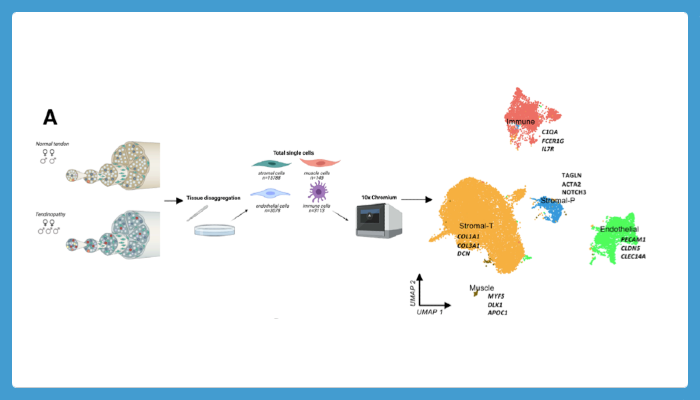Comprehensive tendon atlas
Published: 10 June 2021
New research by Institute scientists has for the first time provided a comprehensive atlas at a single cell level of human tendon in both health and disease.

New research by Institute scientists has for the first time provided a comprehensive atlas at a single cell level of human tendon in both health and disease.
Published in Annals of the Rheumatic Diseases, the study was a collaboration involving iii's Neal Millar, Dr Moeed Akbar, Lucy MacDonald, Dr Mariola S Kurowska-Stolarska, and former Institute Director Professor Iain McInnes.
Using tendon samples from local Glasgow patients donated at the time of surgery, they were able to build a picture of what cells might influence how tendon disease develops.
They found that there was a significant amount of inflammatory cells in samples from patients with damaged tendons compared to normal tendons and propose that these cells and associated molecules may be a key reason why patients end up with damage to their tendons and present with pain.
Neal Millar, a Clinical Senior Lecturer in Immunology at iii and corresponding author, said: "This preliminary tendon atlas highlights cells and pathways that has led to significant changes in how we treat other musculoskeletal disease such as rheumatoid arthritis.
"The fact we see similar changes in tendon means that the potential to target and investigate these pathways in human tendon disease is now compelling."
Single cell and spatial transcriptomics in human tendon disease indicate dysregulated immune homeostasis
- Moeed Akbar, Lucy MacDonald, Lindsay A N Crowe, Konstantin Carlberg, Mariola Kurowska-Stolarska, Patrik L Ståhl, Sarah J B Snelling, Iain B McInnes, Neal L Millar
Cell composition and interactions of healthy and diseased human tendon. (A) Normal (n=4, human hamstring tendon) and diseased (tendinopathy, n=5, human supraspinatus tendon) human tendon were processed for single cell analysis using Chromium 10x 3′DEG chemistry. Infographic shows number of donors and cells sequenced. Uniform manifold approximation and projection (UMAP) embedding of 22 124 single cells delineating endothelial, immune, stromal tenocyte and stromal mural cells with marker genes.
First published: 10 June 2021

